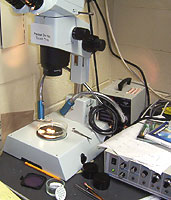|
|
Journals 2003/2004
Deborah Field
South Windsor High School, South Windsor, Connecticut
"Age and Growth of Pelagic and Large Coastal Sharks Using Vertebral Growth Bands"
NOAA Fisheries- Narragansett Laboratory, Rhode Island
July 28 - August 8, 2003
|
DAY 3: Wednesday July 30, 2003
Marine Fisheries
Today I spent the whole day photographing my vertebra sections. It's not easy, but after 53 of them, I've started to get the hang of it. The key to a good photo is the angle of the light. I can see the growth bands really well when the section is sideways on the screen, but I can't photograph them that way because the measuring program won't work. I found that the larger sharks are easier to read even though they are harder to cut. The photo program is called Image-Pro and I thought it was pretty neat. My husband is a professional photographer who really eschews digital photography, but it is really amazing what can be done with it.
I spent some time talking to an intern who wants to pursue a Master's in education. She is getting the run-around from the University, not unlike what I have seen happen at UCONN and Central- everyone seems to have a different answer and none of them are right. I tried to be encouraging and suggested she contact the state department of education. Since they do the certifying, they should have the right answers (although some of my experience in Connecticut has proven otherwise). I find it amazing with all the talk of the need for qualified certified teachers, especially in science, how frustrating and difficult it can be to get certified. I hope that it doesn't discourage people from the profession, no matter what state they are from.
 Lisa's lab got back some shark tag information today. There were 5 Six-gill sharks caught in 1000 feet of water off the Canary Islands. One broke the world record for size at 1340 pounds. The others were 1100lbs, 1040lbs, 1210 lbs, and 1045lbs. All of them were caught with rod & reel - WOW!! They must have taken a long time to pull in. Considering how I've struggled with a 13 inch trout, I can't imagine bringing in a fish that's more than half a ton. Also, these fish were caught less than 5 miles from shore. By New England standards, that's scarily close to shore for such a big fish, but since the Canaries are volcanic, they have a much steeper shoreline, thus much deeper water near shore. I am starting to learn quite a lot about saltwater fishing, something I have never done (except for minnow traps and salt marsh seining). It seems like most of the biological data recorded on pelagic fish comes from fishermen. I suppose that makes sense though. NMFS has tagging programs for nearly everything- sharks, rays, tuna, billfish, etc.
|
|